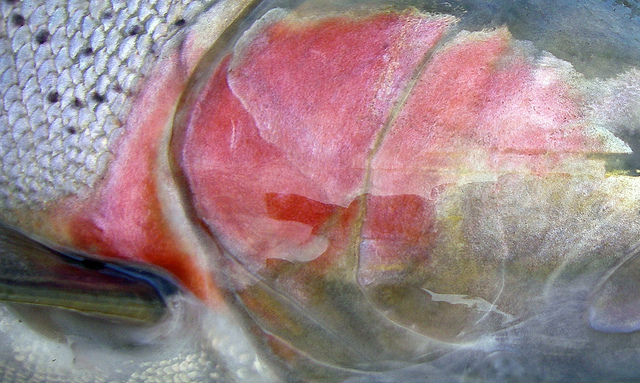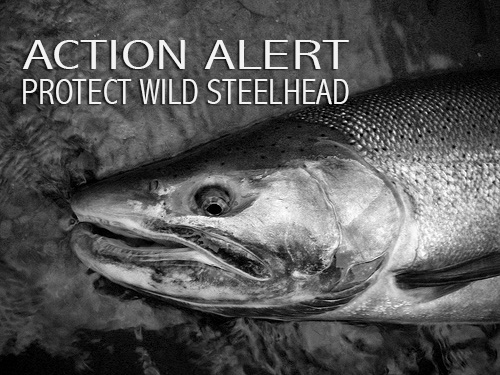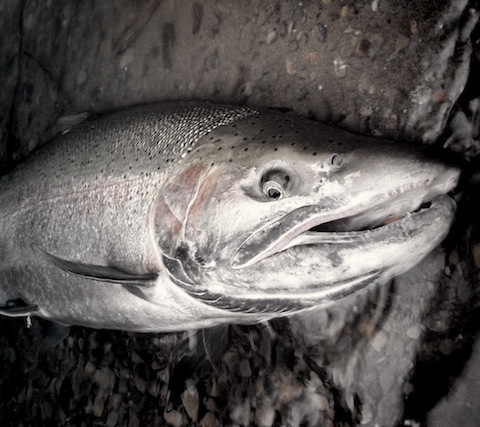If It's For Sale, Should We Eat It?
 Saturday, December 28, 2013 at 12:05AM
Saturday, December 28, 2013 at 12:05AM 
No!
KPLU scratches the surface in this report about wild steelhead making its way to the dining table.
Don't eat wild steelhead....period.
 Saturday, December 28, 2013 at 12:05AM
Saturday, December 28, 2013 at 12:05AM 
No!
KPLU scratches the surface in this report about wild steelhead making its way to the dining table.
Don't eat wild steelhead....period.
 Monday, December 9, 2013 at 12:08AM
Monday, December 9, 2013 at 12:08AM 
In 2004, the Director of the Washington Department of Fish and Wildlife challenged the agency to develop a scientific foundation for a Statewide Steelhead Management Plan (SSMP). Thanks to a broad coalition of individiuals and fish advocacy groups the 2008 final draft of that plan called for the establishment of Wild Steelhead Management Zones, or as they are often referred to today, Wild Steelhead Gene Banks. Fast forward to today and YOU now have the opportunity to help establish of three of the Wild Steelhead Gene Banks.
Thanks to the Native Fish Society it will only take you a minute or two to submit your comment on a proposal to eliminate hatchery steelhead plants as early as next year in three Lower Columbia River tributaries (EF Lewis, Green/NF Toutle and Wind Rivers) to support the recovery of wild fish.
Take action now and let the WDFW and NMFS know that you support management actions that implement the best-available science and recover threatened wild steelhead populations in Washington.
Deadline for comments is this Friday, December 13th.
 Monday, December 2, 2013 at 12:06AM
Monday, December 2, 2013 at 12:06AM 
Act now and submit your comments urging the WDFW to eliminate hatchey steelhead on three lower Columbia tribs!
The Washington Department of Fish and Wildlife (WDFW) is seeking public comments on a proposal to formally end releases of hatchery steelhead in three tributaries of the lower Columbia River to support the recovery of wild fish.
That approach, recommended by three WDFW advisory groups over the past two years, would eliminate the release of all hatchery-raised steelhead on the East Fork Lewis River and the North Fork Toutle/Green River watershed as early as next year.
It would also prohibit future releases of hatchery steelhead in the Wind River, which has not been stocked with steelhead since 1997.
Comments are being accepted on these recommendations through Dec. 13, 2013.
 Thursday, August 15, 2013 at 12:00AM
Thursday, August 15, 2013 at 12:00AM 
Work will ramp up in September leading to an October recommendation where to eliminate hatchery steelhead releases and create a gene bank for wild fish in the Lewis or Washougal rivers.
The Washington Department of Fish and Wildlife has formed a 20-member steelhead management work group to develop regional plans for steelhead in the North Fork Lewis, East Fork Lewis and Washougal rivers plus Salmon Creek.
Federal fishery officials, along with Washington’s 2008 Statewide Steelhead Management Plan, are calling for designation of a network of watersheds where wild steelhead populations are “largely protected from the effects of hatchery programs.’’
LINK (via: The Columbian)
 Thursday, March 7, 2013 at 12:00AM
Thursday, March 7, 2013 at 12:00AM
Some good news from the Native Fish Society
Thanks to continued pressure from our Save Sandy Salmon Campaign, the Oregon Department of Fish and Wildlife (ODFW) suspended its collection of wild winter steelhead this year for its hatchery programs in the Sandy, Clackamas, Santiam, McKenzie and Middle Fork Willamette Rivers.
Hundreds of wild steelhead will be free to spawn in their natal streams this spring instead of being captured and spawned artificially to boost hatchery numbers!
 Thursday, September 20, 2012 at 12:00AM
Thursday, September 20, 2012 at 12:00AM 
From the Wild Steelhead Coalition:
At the beginning of September, the Washington Department of Fish and Wildlife (WDFW) released its draft Hatchery Genetic Management Plans (HGMP) for the Lower Columbia River. These documents spell out WDFW's proposed hatchery operations going forward and outline what impacts their programs will have on ESA-listed wild steelhead in the Lower Columbia. Ultimately, the HGMPs will go to the National Marine Fisheries Service (NMFS) for approval. Unfortunately, the Lower Columbia region is the birthplace of Washington’s long standing hatchery addiction, and reform to some of the more harmful hatchery practices in the change has been slow to come. Specifically, the HGMPs for the South Fork Toutle, Coweeman and East Fork Lewis Rivers call for the continued release of non-native hatchery fish despite the lack of collection facilities in these basins.
By WDFW’s own estimates, hatchery fish are likely severely undermining the productivity of ESA-listed wild steelhead in these watersheds. The department has estimated that around 70 percent of the spawning summer steelhead in the East Fork Lewis River watershed are of hatchery origin, and the other two basins undoubtedly have equally large numbers of spawning hatchery fish. Under the statewide steelhead management plan, this practice was supposed to have been discontinued throughout the state because it guarantees that un-harvested hatchery fish will spawn in the wild. The Toutle, Coweeman and East Fork Lewis are all important wild steelhead producing watersheds for the Lower Columbia, and recovery of wild fish should be a priority in these systems.
Take two minutes to send comments to the Washington Department of Fish and Wildlife (WDFW) and let them know it is time to stop our hatchery steelhead addiction and move toward wild steelhead recovery.